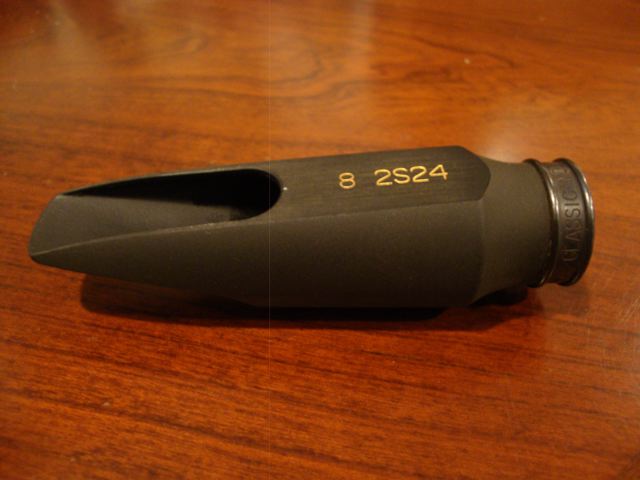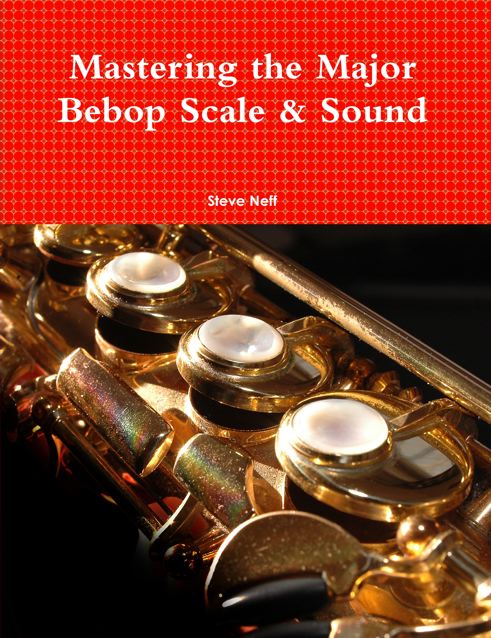Here’s another Theo Wanne tenor saxophone mouthpiece for you to check out. I just received a ton of these and I’m working my way through them as you might have noticed. This is a hard rubber version of the Ambika mouthpiece. The Ambika is on the darker side of the tone spectrum. It has a lower baffle than the Gaia. This is a .110 tip opening. I was hoping for a .105 tip as that is what I liked the best when I tried the metal Gaia out. This tip feels a little larger than I normally like……………………….
Theo Wanne Ambika Tenor Saxophone Mouthpiece
- Appearance:
Again, as with all Theo Wanne products, this mouthpiece looks great. This one is made out of hard rubber and has the logo and “Ambika” engraved on it in gold. The band around the shank looks to be a black metal. Even the ligature it comes with is black. It looks appropriate for a dark sounding mouthpiece. The rails and tip are perfect and even. The chamber and baffle look as good as it gets.
- Tone:
The Ambika has a darker sound then the other Theo Wanne mouthpiece I have tried. Sometimes a darker tone can sound almost dead but I found this mouthpiece very vibrant and the tone nice and thick sounding. Up high the notes were full and round but still darker sounding than many other mouthpieces I have tried. The .110 tip opening felt a little too big for my tastes. I would have loved to try this in a .105 tip.
- Intonation:
Intonation was great with this mouthpiece and within normal limits.
- Control:
The Ambika was easy to play for me although I tend to like a mouthpiece that sounds a bit brighter (It might be because of my hearing loss over the years……….) It played great down low and up into the altissimo and the tone was even up and down the horn.
- Volume:
I could get nice and loud with this mouthpiece although because of the darker nature of the tone I think a mouthpiece like this would get lost in the mix of a rock or pop gig. That’s not it’s thing. I could easily imagine playing this on a jazz trio gig and filling up the room with a nice lush sound.
This is another great mouthpiece by Theo Wanne. For more information on the Ambika tenor sax mouthpiece visit www.theowanne.com .





Thanks for the review.
Hello Steve, I love your reviews about mouthpieces. I am currently interested with the Ambika from Theo wanne.
I am looking for that full, fat, round, vintage otto link if you will kinda sound…
Do you think that this particular mouthpiece can fulfill my needs?
I mostly play on wedding gigs, I need the sound to be more romantic, and big at the same time…
Thank you!
James,
I think the Ambika is a great mouthpiece along those lines. It has a big full sound that is darker and warmer sounding which sounds like what you want. I’m not sure how the Ambika would cut through on a wedding dance set though as most bands get pretty loud on those sets. You’d have to try it out and see. Good Luck. Steve
Hi, steve, thanks for the review! I have 2 questions…
I know a colegue that sells an ambika, he saids that this mp is a older version of ambika, so..
1, have you hear something about?? And 2, what can you tell me about Lebayle LR III HR? (vs ambika)
Pablo,
The Ambika I played and reviewed years ago was a very nice mouthpiece that had a beautiful lush dark sound as I remember. I’ve never played a LR III HR so can’t speak for that. I think I reviewed a LR II at one point but not the III. Steve
Thanks and have a hapy new year
Hi, Steve, It´s me again… I´ve reading and listening your last GAIA 2 soprano mpc review, it look like Theo improve his GAIA from the first, I’ve recent visit the Theo’s page and saw the AMBIKA 2 and I think “can Theo do the same kind of improvement in the AMBIKA than the GAIA?”
I´ll love if you can make a review of the AMBIKA 2 tenor, HR and/or metal.
Hug, Pablo.
Thanks Pablo. I’ll keep that request in mind. There are so many mouthpieces to try and so little time…………Thanks, Steve
Hi Steve, Have you compared this model of the Ambika to the Ambika 2? Just curious to know if there’s much difference in tone. The inside shape looks quite different to the Ambika 2 model (which I have).
Hi Paul, I haven’t tried the Ambika 2 model do I can’t help with your question. Steve
Hi Steve, I thought I give the update here so others can see it too. I tried my Ambika 2 with Rigotti Gold 3 medium reed and I found the famous Rigotti Gold reed buzz (that would be sometimes overwhelming in some rollover baffle or higher baffle mouthpieces) complements the dark character of Ambika very nicely. I am thinking that even a more closed tip opening would shape the tone even further. I suggest if you have a chance try a 7 or 7* tip opening Ambika 2 or 3 with harder Rigotti Gold reeds (3 medium or 3 strong). There is such a big chamber there and plus the shape of interior sides and floor profile that I imagine you would not find 7* and even 7 would limit your air flow but I think the smaller tip contributed to have a more core tone definition which combined with Rigotti Gold buzz creates an interesting combination. It’s probably an odd comparison but it reminds me of a low baffle Berg Larsen kind of tone core.
Thanks, Aria.
How to disagree on a more closed tip opening?
I really like Ambika very much, but I have never heard how the 2 and 3 sounds.
It would be interesting to hear the three models in comparison and, also, in comparison with the Ambika model 3 in metal.
Giuseppe.
Hi Giuseppe, I asked Theo and he said there are a bit more material removed from the side walls so probably adds to the fullness of the tone. I think he adds more boundary layer tricks to his 3 generation with the shark gills to avoid some of the resistance (makes it more free blowing). I’m not sure if I like a super free blowing mouthpiece when the objective is to create a dark tone. Also increasing the cross section means reducing the velocity of air in the mouthpiece which impacts the tone definition. I think already Ambika 2 sounds to me as if it could benefit from more tone definition. Speaking of which, I should let you know that my Roberto reeds that I found too harsh sounding (because of accentuated mid-range) on my baffled early Florida copy sounds great on Ambika. It gains the midrange tone definition that makes the mouthpiece more like a bebop tone. I did a recording of an exact line with 7 different reeds and Roberto 3S won hands down. In front of microphone, Rigotti 3 medium was too buzzy, Select Jazz 3M had a very nasal buzz (my experience from the past as well on other mouthpieces), Vandoren classic 3 was pretty ok but the tone is a bit one dimensional on the high partials although frequency-wise felt balanced between highs and lows, Dáddario Reserve 3 was too reserve (not much tone definition and character), Roberto 3M (felt hard for me so as a result I was gripping my embouchure too much which reduces the vibration so the tone ends up not flattering although had a strong mid-range authority, Roberto 3S which I felt at home embouchure-wise and it had a nice highs and lows and mid-range. It felt just a bit soft for mid to high part of stack but lows were easier and still controlled. With 3M since Roberto leaves a lot of material in the sides about 3/4 of an inch away from the tip compared to most reed makers which thin out the sides in that distance from the tip (if you look to the reed in the light most reeds have a parabola of material shade rather than Roberta shade is across the whole reed till it gets to about 1/2 inch from the tip and then it thins out across the whole reed) as a result the low notes are a bit harder. That seem to be a complaint of some people who don’t want to adjust to this reed. Anyway even with softer 3S reeds, I found the tone definition and mid-range really brought this mouthpiece to life.
Sorry I missed two other reeds. I am a fan of Alexander Superial reeds. They last a very long time, they have a very good tone (expressive with lots of high partials but with balanced lows and warmth so you don’t feel the high partials are overpowering, So I tried it on two different kind of Superial and Superial DC. I think instead of #3 if I had 3.5 I could push it to the category of authority of tone of Roberto but with #3 it kind of felt as if I have buzz and low-mid frequencies but lacking some high-mid frequencies. They were pretty close to be Ok though.
Hi, Arya,
it is always a pleasure to talk to a person as helpful and kind as you and who shares his great experience with others.
I noticed that you are really well versed in reeds …
Here in Rome, by now, due to online competition, the shops are either closing or have almost nothing but the major commercial brands: all the brands you recommend here are not found, like Roberto … and I have no technical knowledge of the nomenclature of the parts of the reeds that combine to form the characteristic sound in the reeds, like you, I go mostly by ear and intuition.
I have tried, in practice, over time, from the 70s to today, only the major reeds at the time (and in the shops in Rome marketed) known from then to today: in order of time: Rico normal, american cut, “red” (very hard and all different in the box), Rico Royal (french cut), LaVoz, Rico Plasticover, Hemke, Rico Jazz, Vandoren various types (I didn’t like Java greens) with preference for ZZ (american cut) and Java red (french cut), Rigotti Gold.
I have noticed that, in general, over time the quality has gone, for my tastes, getting worse and the price increasing.
I remember that the Hemke, which I used with a Dukoff S 7 in the late ’80s and early ’90s, at the time, with this set up, I liked a lot because their tip vibrated a lot and emitted a very pleasant buzz, and they were a little pleasantly dark; they also enhanced the timbre of the highest notes and also of the lowest ones.
I don’t know if they sound like they did then, I can’t find them, also because I haven’t played for two years due to contingent problems and I have little time to go out …
I’m looking for them in stores because I don’t buy online but, as mentioned, it’s difficult; it is also difficult to go around shops because in Rome, by car, there is a lot of traffic and, for Covid, I consider it dangerous to get on public transport, which is very crowded!
I think that, if you have never tried them, if they are like then, the Hemke, now called “Rico Hemke” (take a half size less than usual because they are very hard) you should like them: they vibrated a lot and have “thinner tips and shorter vamp” (information take on the web): I remember that they had the part that vibrates very short. I don’t remember if they are filed or unfiled.
My teacher, a professional, who for a while I’ve only heard on the phone, has been looking for them lately and is buying many … So I think the new ones are as good as the old ones I remember …
Regarding the Ambika mouthpieces I really liked the first model, both in HR and in metal; I asked Theo Wanne’s website e-mail for a comparison between model 1, 2 and 3, played by the same saxophonist, because I think I prefer the sound of model 1, also for the reasons you explained.
I like a mouthpiece that offers some “good” resistance, to allow time to shape the sound.
There is a lot of video and audio from Model 1, but few related to Models 2 and 3.
Brian replied to the e-mail and wrote me that they only sell model 3 and that it is a good idea, the comparison, and that he would talk to Theo about it …
Let’s see what happens …
However, I prefer mouthpieces with little tip opening, for a sound with more projection. At first Theo also did tip opening 5 or 5 *, I don’t remember well … Now they start at 6 *.
It is strange to buy a mouthpiece without trying it, both for the sound and for the measure …; as for shoes: who would buy shoes without trying them on?
See you soon, greetings,
Giuseppe.
Sorry Steve for dragging the comments on for this mouthpiece.
Giuseppe, if you have Vandoren stuff available, you can try V16 #3 or 3.5. They have an accentuated high mid-range that complements strong low mid-range of this mouthpiece nicely and adds to the tone definition and liveliness of tone overall. They are sort of in the realm of the tone of Roberto reeds with slightly less warmth but pretty close. Also, La Voz medium or medium hard is a good choice, it has a bit less mid-range than V16 but the warmth similar to Roberto reeds with a decent tone definition.
Thanks Arya (and sorry Steve),
I don’t have, unfortunately, an Ambika mouthpiece but a Meyer M6M for tenor …
I tried the V16s but I found them as, for example, also the Java greens, at least the ones I tried, played by me and with my mouthpiece, a little too similar to the sound of plastic reeds; at least the ones I have tried.
The LaVoz that I tried three years ago, compared to those of the ’70s, I found a bit unreliable, in the sense that each time they reacted differently in playing; moreover, they often curled and deformed and were not “mouthpiece friendly”: it was enough to pass them from one mouthpiece to another and they stopped playing … Another problem is that, when they are running out, they “die” suddenly, suddenly stopping playing and without playing for a while longer, like the other reeds … It’s a shame because the timbre is very beautiful and rich, when you find a good one!